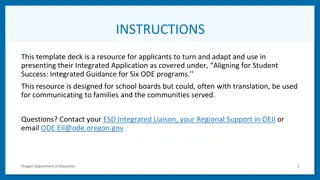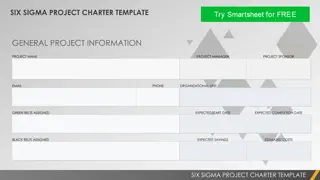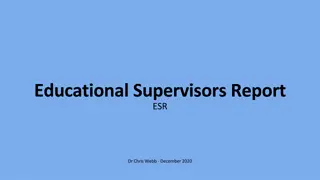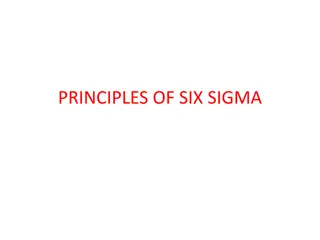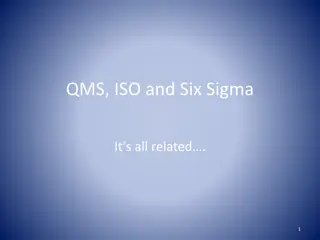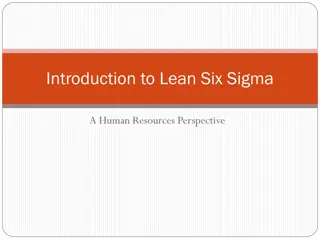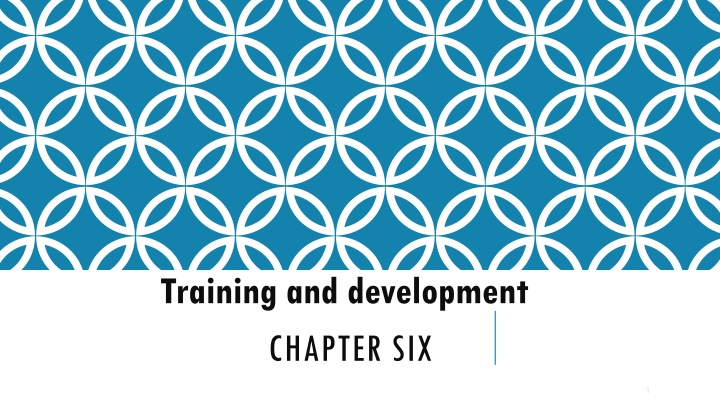
Training and Development in Human Resource Management
Explore the significance of Human Resource Development (HRD) in organizations, focusing on the three primary functions: training and development, organizational development, and career development. Learn about the essence of learning, training, and development processes to enhance skills and capabilities, ultimately improving job performance and productivity. Discover the major purposes of training and development, along with the essential steps involved in designing and conducting HRD interventions.
Download Presentation

Please find below an Image/Link to download the presentation.
The content on the website is provided AS IS for your information and personal use only. It may not be sold, licensed, or shared on other websites without obtaining consent from the author. If you encounter any issues during the download, it is possible that the publisher has removed the file from their server.
You are allowed to download the files provided on this website for personal or commercial use, subject to the condition that they are used lawfully. All files are the property of their respective owners.
The content on the website is provided AS IS for your information and personal use only. It may not be sold, licensed, or shared on other websites without obtaining consent from the author.
E N D
Presentation Transcript
Training and development CHAPTER SIX 1
HUMAN RESOURCE DEVELOPMENT Is defined as a set of systematic and planned activities designed by an organization to provide its members with the opportunities to learn necessary skills to meet current and future job demands. The three primary functions of HRD are training and development, organizational development, and career development. Learning is at the core of all HRD efforts. 2
LEARNING Learning is the process by which a person acquires and develops new knowledge, skills, capabilities and attitudes. learning is goal directed, it impacts behavior and cognition, and the changes brought about are relatively stable. Learning has happened when people can demonstrate that they know something that they did not know before (insights, realizations as well as facts) and when they can do something they could not do before (skills) .
TRAINING Training - is the use of systematic and planned instruction activities to promote learning. It involves the use of formal processes to impart knowledge and help people to acquire the skills necessary for them to perform their current jobs satisfactorily.
DEVELOPMENT Development - enables people to progress from a present state of understanding and capability to a future state in which higher-level skills, knowledge and competencies are required. It takes the form of learning activities that prepare people to exercise wider or increased responsibilities. It does not concentrate on improving performance in the present job.
MAJOR PURPOSES OF TRAINING AND DEVELOPMENT Establish sound relationship between the worker and his/ her job Upgrade skills and prevent skills obsolescence Increase productivity and quality of work Improves labor-management relations Minimize operational error (wastage, unnecessary repetitions, reduce accident) Help address performance deficiencies caused by lack of skills, knowledge and experience 6
Human resource Development process HRD interventions should be designed and conducted using the following steps : 1. needs assessment, 2. design, 3. implementation, and 4. evaluation
Step1: Conducting need Assessment Need assessment refers to a systematic identification of training and development needs. Training need is the gap between skills needed for a job and the present skill level of employees. Training and development needs are identified by comparing job performance standard and actual performance. If the actual performance is below the job standards it indicates performance deficiencies. 8
Step1: Conducting need Assessment Levels of training need analysis Organization analysis - is an examination of the environment, strategies, and resources(technology, financial and HRM) the firm faces so as to determine what training it should emphasize. Source of Data for organizational analysis Secondary(strategic plan, operational plan, proposed initiatives, financial plan) Top management 9
Step1: Conducting need Assessment Levels of training need analysis Task analysis- involves reviewing the job description and specifications to identify the activities performed in a particular job and the KSAs needed to perform them. i.e, The process of determining what the content of a training program should be on the basis of a study of the tasks and duties involved in the job. 10
Step1: Conducting need Assessment Levels of training need analysis A person/individual analysis- involves determining which employees require training and, which do not. Performance appraisal information can be used for the purposes of conducting a person analysis. Source of data , employee + immediate supervisor Purpose of Conducting a person analysis Helps organizations avoid the mistake of sending all employees into training when some do not need it. Helps to determine training programs 11
EFFECTIVE NEED ANALYSIS WILL LEAD TO :- Identifying the training goal (what problem the training is hoping to solve?) Identifying the training content- what trainees are going to learn Identifying The learners current capabilities Identifying the context of the training
STEP2: DESIGNING THE TRAINING PROGRAM 1. Identifying trainees and Setting learning objectives are desired outcomes that the training is intended to achieve Learning objectives describe the skills or knowledge to be acquired and/or the attitudes to be changed. Example: "At the end of the course, learners will be able to work cooperatively in a small group setting.
STEP2: DESIGNING THE TRAINING PROGRAM 2. Identifying Training content Training contents are what the trainees will learn in order to achieve the intended training objectives. 3. Determining sequencing approach of the content-how the training material is going to be presented. Step-by-step sequencing- Learners are introduced to a task by the steps in the task itself. first you do this, then you do this.
STEP2: DESIGNING THE TRAINING PROGRAM 3. Determining sequencing approach of the content-how the training material is going to be presented. Chronological Sequencing- the content is arranged by time sequence. first this happened , then this happened. Whole to part sequencing- Learners are first presented with a complete model or a description of the work duty. Part-to-whole sequencing- Learners are presented with each part of a system. then they learn how that part fits into the system as a whole. Simple-to- Complex sequencing- content is arranged from simplest task to the most complex task.
WHAT SEQUENCING METHOD WOULD YOU USE TO TEACH THE FOLLOWING TOPICS? Process of job analysis Human resource information system Evolution of management theory HR Supply forecasting methods
STEP2: DESIGNING THE TRAINING PROGRAM 4. Identifying trainer/s- characteristics of effective trainers are:- Knowledge of subject Interest in the subject matter Ability to give Clear instructions Adaptability ability to adapt to the different learning ability of trainees. Individual assistance-When training more than one employee, successful trainers always provide individual assistance
STEP2: DESIGNING THE TRAINING PROGRAM 5. Determining training method/s Training methods refers to the approach needed to teach specific skills, knowledge and influence attitudes. A major consideration in choosing among various training methods is determining which ones are appropriate for the KSAs to be learned.
TRAINING METHODS On the Job Training: A method by which employees are given hands-on experience with instructions from their supervisor or other trainer. In this program the employee is placed in to real work situations and shown how the job is performed by experienced worker or supervisor. Conducted in the place where the employee is actually working. Requires setting specific training schedule, evaluation and feedback session for each trainee. 19
ON THE JOB TRAINING STEPS:- 1.Preparation:the trainees are told about the job, purpose and expected outcome of the training 2.Demonstration (presentation):the trainees are given instruction by telling, showing and explaining about the job knowledge and skills 3.Practice: The trainees are given opportunity to actually perform the job to demonstrate their understanding. Errors are corrected. Practice is continued till the employee is able to perform the job with out supervision. 20
TRAINING METHODS 1. Information presentation methods: Used to teach facts, skills and concepts without requiring the trainee to practice the materials thought. Lecture Conference Programmed instruction-utilizes books, manuals, or computers to break down content into sequences for employees to learn at their own pace. 21
TRAINING METHODS 2.Simulation Methods: This method presents trainees with artificial representations of an actual situation and require them to react as though the situation were real. Role playing- Consists of playing the roles of others, who are facing a particular problem. Case study- Using documented examples, case-study participants learn how to analyze (take apart) ,synthesize (put together) facts and make decisions. 22
TRAINING METHODS 3. Apprenticeship training A system of training in which a worker entering the skilled trades is given thorough instruction and experience, both on and off the job, in the practical and theoretical aspects of the work. 4. Vestibule Training: Trainees learn their jobs on the equipment they will be using on the job. The training is conducted away from the actual work environment. 23
STEP 3: IMPLEMENTING THE PROGRAM Inform learners Arrange off site or on site classrooms Avail necessary aiding materials Deliver the program as per schedule 24
STEP4: EVALUATING THE PROGRAM Purpose is to verify the success or failure of the program Evaluation results provide feedback to improve current activities and plan-future training programs. 25
Criteria for evaluation Criterion 1: Reactions what trainees think about the overall training. What were your learning goals for this program? Did you achieve them? Did you like this program?
Criteria for evaluation Criterion 2: Learning to assess what trainees actually learned. Testing the knowledge and skills of trainees before and after a training program will help determine their improvement.
Criteria for evaluation Criterion 3: Behavior- focuses on assessing whether learnings from the training are transferred to the work. The transfer of training refers to how well employees apply what they have learned to their jobs.
Criteria for evaluation Criterion 4: Results, or Return on Investment (ROI) A company s ROI refers to the benefits it derives from training its employees relative to the costs it incurs. ROI = Results/Training Costs, i.e., ROI >1 How much did quality improve because of the training program? How much has it contributed to profits? What reduction in wasted materials did the company get after training? How much has productivity increased, and by how much have costs been reduced?




